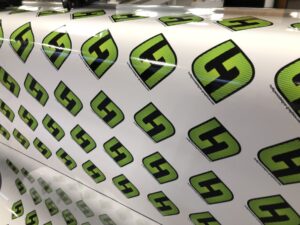
Creating print-ready artwork is important as it ensures your designs look professional and polished once printed. But what does “print-ready” really mean? Simply put, it’s artwork formatted to meet specific technical printing requirements. When your art is properly prepared, you avoid errors, delays, and subpar results.
Let’s dive into what makes artwork print-ready and why it matters for your signage and printing projects.
Vector vs. Raster: Why the Format Matters
One of the most critical aspects of print-ready art is choosing the right format: vector or raster.
- Vector Graphics: These files are made of points, lines, curves, and shapes rather than pixels, making them scalable to any size without losing quality. Logos, text, and graphics are typically created as vector files (.AI, EPS, or .PDF) for clean, sharp results.
- Raster Graphics: These are pixel-based images (like .JPG, PNG, or .TIFF). While ideal for photos, raster images need to be high-resolution to avoid looking blurry or pixelated when printed.
For most signage, vector files are preferred because they maintain their clarity, no matter the print size.

The Importance of Fonts in Print-Ready Art
Fonts can easily cause issues if they aren’t properly prepared for printing. If the printer doesn’t have your specific font installed, the text could appear incorrectly or be replaced with a generic font. To prevent this:
- Outline Your Fonts: Convert the text into a vector graphic so the font is no longer editable but will display correctly.
- Embed Fonts: If your file format allows, embedding ensures the fonts travel with the design file.
Resolution: Clear Images Every Time
Resolution is another crucial factor for print-ready art. The standard for high-quality printing is 300 DPI (dots per inch). Anything lower, especially for raster images, can result in a blurry or pixelated print. For example, a photo taken on your phone might look sharp on-screen but lack the resolution needed for large-scale prints.
PMS and CMYK: Getting Colors Right
For accurate color reproduction, it’s essential to use the correct color mode.
- PMS (Pantone Matching System): Provides consistent, precise color matching across all printed materials, ensuring your brand colors are exact.
- CMYK (Cyan Magenta Yellow and Key (Black) Is used for digital printing. CMYK offers reliable color reproduction when PMS isn’t an option. Avoid using RGB, as it’s intended for digital screens, not printing.
Why Print-Ready Files Save Time and Money
Using non-print-ready files—like low-resolution photos or designs with missing fonts—can lead to delays, additional costs, and disappointing results. Properly preparing your artwork ensures that the printing process runs smoothly and delivers the high-quality results you expect.
Need help getting your artwork print-ready? At Hollywood Signs and Graphics, we can guide you through the process and ensure your designs look their best. Whether you need help creating print-ready files or producing top-quality signage, we’ve got you covered!
Browse our signage capabilities online, complete our contact form, and let us help bring your designs to life with precision and professionalism.


Leave a Reply